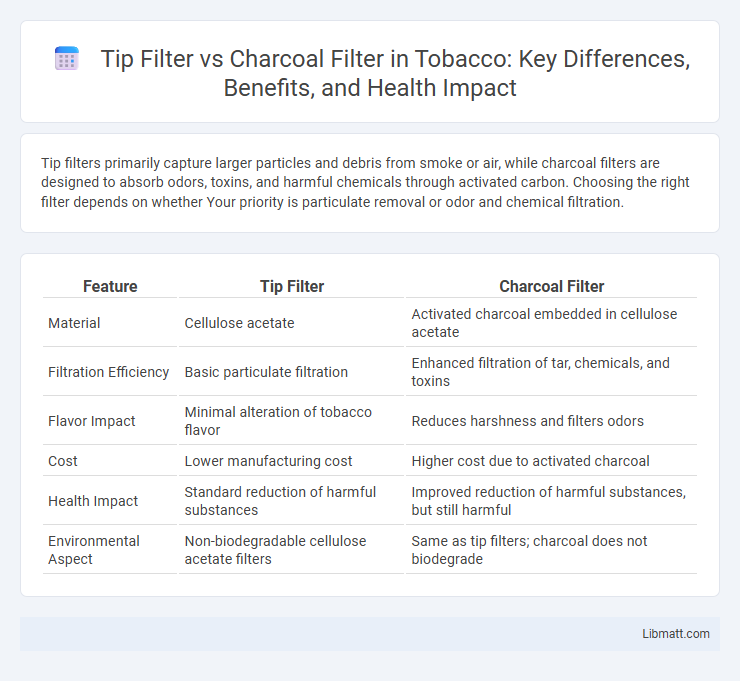Tip filters primarily capture larger particles and debris from smoke or air, while charcoal filters are designed to absorb odors, toxins, and harmful chemicals through activated carbon. Choosing the right filter depends on whether Your priority is particulate removal or odor and chemical filtration.
Table of Comparison
| Feature | Tip Filter | Charcoal Filter |
|---|---|---|
| Material | Cellulose acetate | Activated charcoal embedded in cellulose acetate |
| Filtration Efficiency | Basic particulate filtration | Enhanced filtration of tar, chemicals, and toxins |
| Flavor Impact | Minimal alteration of tobacco flavor | Reduces harshness and filters odors |
| Cost | Lower manufacturing cost | Higher cost due to activated charcoal |
| Health Impact | Standard reduction of harmful substances | Improved reduction of harmful substances, but still harmful |
| Environmental Aspect | Non-biodegradable cellulose acetate filters | Same as tip filters; charcoal does not biodegrade |
Introduction to Tip Filter and Charcoal Filter
Tip filters primarily function as mechanical barriers that trap larger particles such as dust and debris, making them ideal for environments requiring basic filtration. Charcoal filters utilize activated carbon to adsorb odors, gases, and chemical impurities, offering advanced purification especially beneficial in air and water treatment systems. While tip filters focus on physical filtration, charcoal filters provide both physical and chemical purification for enhanced air and water quality.
What Is a Tip Filter?
A tip filter is a type of cigarette filter composed primarily of cellulose acetate fibers designed to reduce tar, nicotine, and other harmful substances inhaled during smoking. Unlike charcoal filters, which contain activated carbon to adsorb toxins and impurities, tip filters primarily function by physically blocking particulate matter. Their lightweight design offers minimal filtration compared to charcoal filters, which are more effective in improving smoke quality by trapping volatile organic compounds.
What Is a Charcoal Filter?
A charcoal filter is a type of air or water filter that uses activated carbon to remove impurities, odors, and toxins through adsorption. Unlike tip filters, which primarily trap larger particles and reduce contaminants mechanically, charcoal filters chemically bind contaminants at a molecular level for more effective purification. Commonly used in air purifiers, water filtration systems, and smoke filtration, charcoal filters enhance overall air and water quality by targeting volatile organic compounds (VOCs) and harmful gases.
How Tip Filters Work
Tip filters work by embedding activated charcoal within the cigarette filter to absorb harmful chemicals and toxins from the smoke before it reaches Your lungs. These filters capture tar, nicotine, and other dangerous substances, reducing overall inhalation of carcinogens. The efficiency of tip filters depends on the density and quality of the charcoal used, significantly impacting smoke filtration and taste.
How Charcoal Filters Function
Charcoal filters function by using activated carbon, which has a porous structure that traps contaminants and impurities from air or water. The activated carbon adsorbs odors, chemicals, and volatile organic compounds, improving air quality or water taste effectively. This filtration process makes charcoal filters highly efficient in removing unwanted particles compared to basic tip filters.
Key Differences Between Tip and Charcoal Filters
Tip filters primarily reduce tar and nicotine by providing a physical barrier, while charcoal filters use activated carbon to absorb harmful chemicals and toxins from cigarette smoke. Charcoal filters offer enhanced filtration of volatile organic compounds and unpleasant odors compared to tip filters, improving the smoking experience. The choice between tip and charcoal filters affects both the taste and health impact of smoking due to their distinct filtration mechanisms.
Effectiveness in Reducing Harmful Substances
Charcoal filters outperform tip filters in reducing harmful substances by effectively adsorbing toxic chemicals such as benzene, formaldehyde, and heavy metals from smoke or air. Tip filters primarily remove larger particles and some tar but lack the porous surface area necessary for significant chemical adsorption. Studies show charcoal filters can reduce certain carcinogens by up to 50%, providing a more substantial health benefit in filtration applications.
Impact on Flavor and Smoking Experience
Tip filters subtly soften smoke, reducing harshness and providing a smoother smoking experience by trapping larger particles and tar. Charcoal filters actively absorb impurities and odors, significantly enhancing flavor purity and delivering a cleaner, more refined taste. Your choice between tip and charcoal filters directly influences the balance of flavor intensity and smoke smoothness in each puff.
Cost and Availability Comparison
Tip filters generally cost less due to simpler materials and widespread manufacturing, making them highly available in most markets. Charcoal filters, containing activated carbon, tend to be pricier but offer enhanced filtration benefits, which can justify the cost for specific applications. Both filters are commonly found, but charcoal filters may be less accessible in remote areas due to higher production and shipping expenses.
Choosing the Right Filter: Which One is Better?
Choosing the right filter depends on your specific needs and environment; a tip filter excels at removing larger particles such as dust and lint, while a charcoal filter offers superior absorption of odors, gases, and chemical pollutants. If your goal is to improve air quality by eliminating smells and harmful vapors, the activated charcoal filter is more effective. Your decision should weigh particle size filtration versus odor control to match the filter's capabilities with your air purification priorities.
tip filter vs charcoal filter Infographic

 libmatt.com
libmatt.com